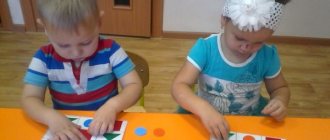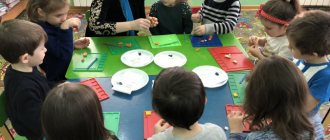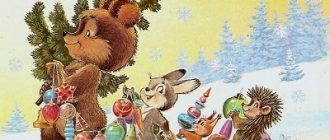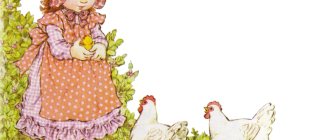Abstract of GCD - formation of elementary mathematical concepts in the senior group
Abstract of GCD on cognitive development - the formation of elementary mathematical concepts in the senior group
Topic: “The story of Pin and Gwin”
Types of activities: gaming, cognitive-research, communicative.
Educational objectives:
- exercise children in counting within 10; ability to generalize, compare, identify patterns
- consolidate children’s knowledge: about the measurement of liquid bodies, some properties of geometric shapes, parts of the day, days of the week
Developmental tasks:
-develop fine motor skills, attention, logical thinking
Educational tasks:
-develop a sense of mutual assistance, self-control and self-esteem skills
Demonstration material : models of rocks with different lighting of steps, Dienesh blocks, two vessels with liquid, two identical empty vessels, explanatory dictionary
Handouts : little penguins (origami), red pencils, mazes, fishing rods, diagrams of Dienesh blocks, sets of geometric shapes
Progress:
— Guys, today I want to tell you a story about the little penguins Pin and Gwin, who live in Antarctica. They go to school. One day the teacher gave them very difficult tasks. Pin and Gwyn could not solve them. I think we can all help them together.
1.Tasks on counting, attention and logic:
- Pin caught 5 fish. If he gives one fish to Gwin, they will have an equal share. How many fish did Gwin catch?
- Pin felt cold. To keep warm, he jumped 6 times. Gwin also decided to warm up and jumped 4 times. Who is colder: Pin or Gwyn?
- The wizards hid parts of the day under different rocks.
It is known that
-at the first rock there are more than 2 steps, but less than 4, illuminated by the red sun. (evening)
-at the second rock, more than 6, but less than 8 steps are illuminated by the yellow sun. (morning)
-at the third rock there are more than 10 steps illuminated by the bright yellow sun. (day)
-what part of the day is behind the last rock if all the steps are dark? (night)
2. At school the penguins have a geometry lesson. The penguins were given a task - to come up with a toy for the Ice Rock holiday. What could you offer them using geometric shapes on trays? Children lay out and tell what geometric shapes his toy consists of.
3. Sometimes, returning from school, the little penguins lost their way home. Take a red pencil and mark on your plans the path along which the penguins returned home. (Guys do a task with a labyrinth )
4. While Pin and Gwin were studying, their mother went to visit her sick grandmother and said that she would return on the first day after the weekend. Tell me, when will mom return? What days did the little penguins go to school?
-The little penguins wanted to cook dinner for their mother, but there was no fish. What to do? (children's options)
-Of course, they went to the ice hole to catch fish. What is an ice hole? Where can we find out the meaning of this word? Children's options. The meaning of the word “ice hole” is read from an explanatory dictionary
They walked and had fun. I suggest everyone play a little too.
Physical education minute
5.Task with Dienesha blocks
-The little penguins decided to catch these fish. The teacher shows a drawing of a fish, and the children match it with a card from the set of Dienesh blocks. They take fishing rods and hook geometric shapes according to the given properties.
-Which fish do you think is the heaviest, how can you find out? (weigh)
-While the penguins didn’t have the fish, what was their mood? (sad, etc.)
-When did you catch the fish? (fun, etc.)
6. Pin and Gwin were happy that they had caught a lot of fish. They began to play around, have fun and confused the vessels with drinking water for cooking and with bitter medicine. But it was known that there was more water than medicine. How can I help, can I try? The guys come to the decision that they need to be measured with the same yardstick.
“When my mother returned, they vied with each other to tell her how they spent their time.
Result:
— Did you like the story about Pin and Gwin? Tell us how you helped them?
-Now look at the flowers that are on your table and choose a flower that tells you how you managed to help the penguins today.
-If very good, take a flower with five petals
-If you find it difficult, take a flower with three petals
-I also want to give everyone gifts from Pin and Gwin (origami penguin)
Abstract of GCD on FEMP on the topic: “Properties of objects”
Author: Apreleva Marina Gennadievna
Teacher of MBDOU CRR kindergarten No. 142 “Rosinka”, Ulyanovsk
Abstract of GCD on FEMP on the topic: “Properties of objects”
Municipal budgetary preschool educational institution "Kindergarten No. 142 "Rosinka"
Abstract of GCD on FEMP on the topic: “Properties of objects.”
Prepared by:
teacher
Apreleva M.G.
2020
Target:
To consolidate children's understanding of the properties of objects, the ability to find signs of their similarities and differences, to combine objects in a group according to a common characteristic (color, shape, size, material, purpose, etc.).
Tasks:
- Repeat and consolidate ideas about the shapes of geometric figures - square, circle, triangle, rectangle, oval.
- Develop attentiveness, creative imagination, ingenuity, the ability to substantiate your point of view, and draw conclusions.
- Develop the ability to work independently, develop self-control skills, and cultivate a friendly attitude towards each other.
Techniques used to guide children's activities:
Motivation
: surprise moment, commenting.
Activation of children's activities:
conversation, creating a developmental environment, posing a problematic question, solving a mathematical riddle.
Organization of practical activities:
showing illustrations, commenting, using the game “Geometric Shapes”, a mathematical riddle.
Motivation and maintaining interest:
surprise moment, situation of choice, physical activity, change of activities.
Assessment of children's activities, activation of self-esteem:
encouragement
Subject development environment for OOD:
models of geometric shapes: small and large red circles, small and large blue squares, large blue rhombus, large blue rectangle, large red oval, two small green triangles, large green equilateral triangle, large green equilateral triangle, large green isosceles triangle, rope with tied ends, an envelope with a “letter” from the Kingdom of Geometric Shapes, decorated with stickers of geometric shapes, a magnetic board.
Handout:
sheets of white paper, simple pencils, rulers with a stencil (geometric shapes)
Activities of children in OOD:
cognitive, gaming, communicative, motor.
Educational areas:
cognition (FEMP), physical development, communication, speech development.
OOD Plan
1.Introductory part – 2 min. Psychological mood. Surprise moment.
- Main part – 20 min. A conversation about the shapes of geometric figures. Didactic game "Geometric shapes". Dynamic pause "Wizards". Game "Characteristics and similarities of geometric shapes." Physical school
- Final part - 3 min. Physical education minute. Summing up the OOD. Assessment of children's activities.
Duration of OOD
– 25 min.
Progress of OOD
- Introductory part.
Psychological mood.
All the children gathered in a circle,
I am your friend and you are my friend
Let's hold hands tightly
And let's smile at each other.
IN:
I will smile at you, and you will smile at each other, so that you and I will have a good mood all day.
(pay attention to the envelope with the “letter” from the Kingdom of Geometric Figures)
IN:
Guys, look, we have received a letter. Let's read it.
“Dear guys! Marina Gennadievna, told me how well you know geometric shapes. That's why I decided to send you a game as a gift. I think you will definitely like it!
And of course, I invite you to visit me in the Kingdom of Geometric Shapes. See you soon!
Queen Mathematics"
IN:
Look at the blackboard. What do you see?
D:
geometric figures.
IN:
Let's remember the names of these geometric shapes.
Children name geometric shapes.
IN:
What do you know about this geometric figure?
(The teacher shows geometric shapes: square, triangle, circle, oval, rectangle
)
What is it called? How many angles does it have? How many sides? What shape does it have?
Children must name the color, size, shape.
- It's a little red circle.
- This is a small blue square.
- This is a small green triangle, etc.
- Main part.
Didactic game "Geometric shapes".
Let's look at our figures too
(pictures change on the board)
IN:
Please describe the changes that have occurred to the figures.
D:
the small red circle turned into a big red circle at first. The size has changed, but the shape and color have not changed.
And then the small red circle turned into a large red oval, the size and shape changed, but the color did not change.
D:
blue square. At first the size changed, the shape and color did not change.
Then the size and shape changed, but the color, number of corners and number of sides did not change.
Then the size and color changed, but the shape did not change.
D:
The same changes have occurred with the small green triangle. First the size changed, but the shape and color did not change.
Then the size and shape changed, but the color did not change. Then the size, shape and color changed, it turned into a large red square.
Dynamic pause "Wizards".
IN:
Have you seen what transformations took place with a circle, a square and a triangle. Now let’s play a little and build geometric shapes ourselves. For this we need this rope. I will show you a geometric figure, and you will all try to make it together.
(children stand in the center of the room, receive a rope with tied ends, take it with both hands and, at the teacher’s signal, form various geometric shapes. At the same time, the features of geometric shapes are repeated: an oval and a circle have no corners; a triangle has three angles and three sides, and a square and rectangle have four angles and four sides; A square has all sides equal, but a rectangle has only opposite sides.
).
Consolidating representations of the properties of objects.
Game "Characteristics and similarities of geometric shapes."
IN:
I have three envelopes with geometric shapes in my hands. You can identify the similarities and differences between these figures.
Sample answers from children:
D:
1) in the first envelope there are two blue figures. Both figures are blue, but one of them is a square, and the second is a circle. They differ in shape.
2) in the second envelope there are two triangles. They have the same shape and size. But these triangles have different colors: the first is red, the second is yellow.
3) the third envelope contains a rectangle and an oval. They have a common property - size. And they differ from each other in color and shape: the rectangle is green, and the oval is orange.
Physical exercise.
IN:
I will show you geometric shapes, and you perform the action that suits exactly this figure (
square - bends, triangle - turns, oval - squats, circle - jumps
).
Be careful.
Independent work.
Game "Orientation on a plane"
IN:
Now the task is on orientation on a plane. In front of you are sheets of white paper, simple pencils and stencil rulers with geometric shapes. Show me your right hand, now your left. Now show the upper right corner on a piece of paper. Now bottom left, etc. Your task, having seen the geometric figure that I will show, is to circle exactly in the corner where I say. We will do all this in silence. And at the end of the task, we will check whether everyone completed the task.
(the teacher shows a square and asks to circle it in the upper right corner, etc. with a circle, triangle, oval, rectangle
)
The task is completed independently.
IN:
what geometric figure is in the upper left corner? In the lower right? Etc.
- Final part.
IN:
Guys, what figures did we work with today?
How can we call them in one word?
What exactly did we do?
The geometric shapes are hidden so well in the group, let's find them.
(children find familiar geometric shapes in the environment. For example: a clock dial, window frames, etc.).
Reflection
.
IN:
What do you remember most today?
IN:
What was difficult for you? What was easy?
IN:
Appreciate your work with the help of the sun.
IN:
I think we did a good job today. Well done! Real experts in geometric shapes. It was a pleasure to play with you today.



